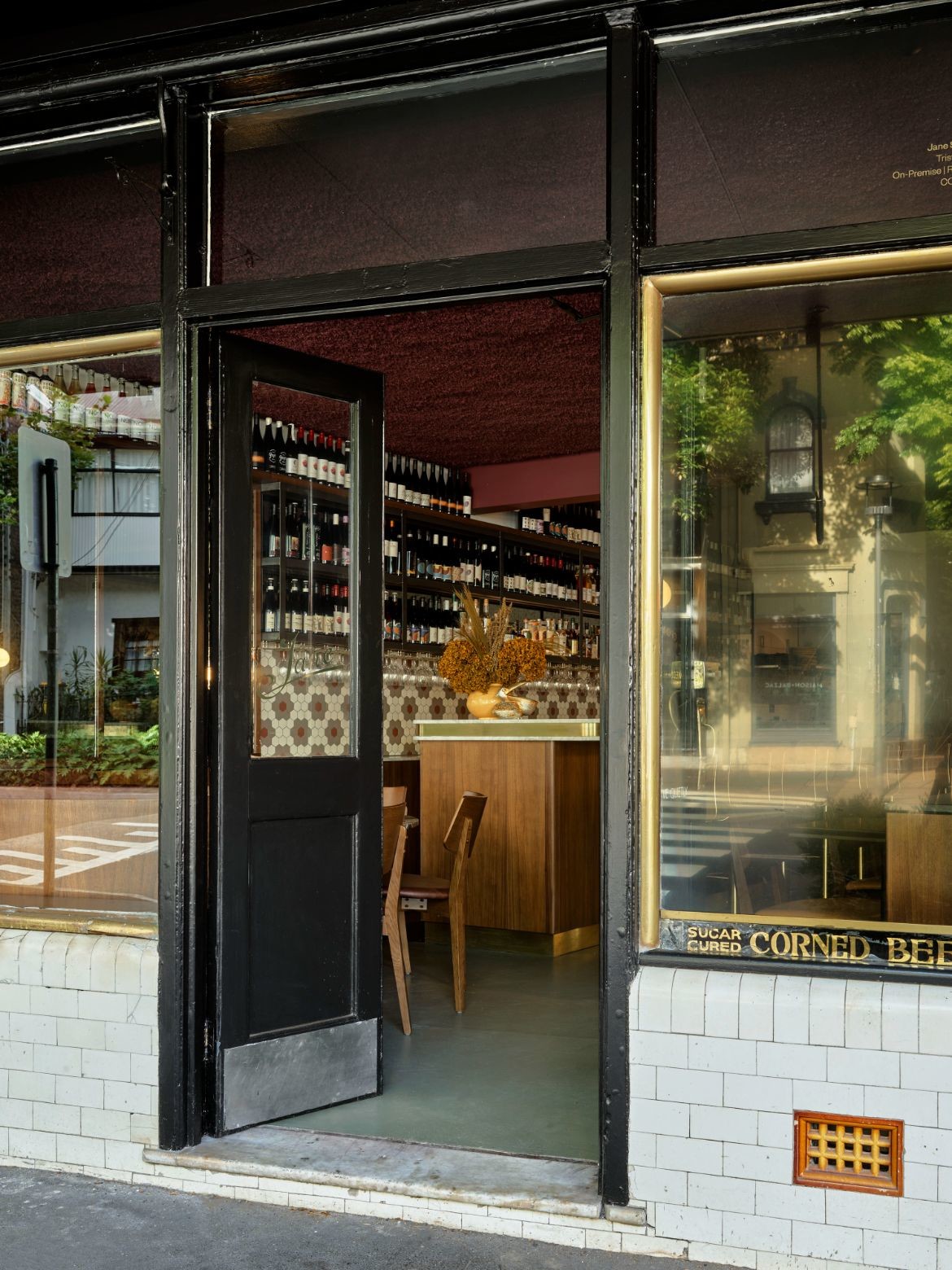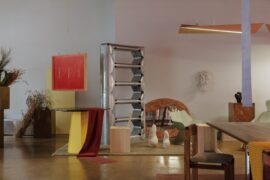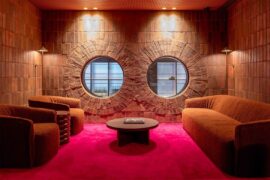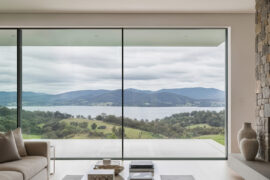At Jane in Sydney’s trendy Surry Hills, Luchetti Krelle has created a sumptuous dining environment with French touches and a local palette. From floor to ceiling, it’s all about materials, tones and making the most of a decidedly intimate space.

December 14th, 2022
Located in the Paris end of Surry Hills and designed by Luchetti Krelle, Jane is everything a local bar and bistro should be. Honing their skills through a portfolio of highly impressive hospitality venues, Luchetti Krelle get it right in astounding ways. For Jane, their skill is writ large in that the intimate space is richly layered without being at all cluttered. Nor has it gone to the other extreme of looking empty.
There is a slight seventies vibe, so contemporary, without being overblown. Repeated timber booths with thick corduroy backrests and leather bases are a particularly seventies nod, as is the vintage brass pendant lamp that takes pride of place over the gorgeous Rosso Lavanto marble dining table – complete with Lazy Susan. Otherwise, Jane is more French than anything else, with marble and brass in particular carrying the European mood. Patterned tiles and herringbone timber floors likewise point to Europe, but with a shifting reference that floats from seaside cafe to cosy bistro.

There is also a brilliant take on Australian influences introduced via saturated colour: “It became apparent that many of the ingredients of the dishes would incorporate Indigenous Australian ingredients, so tones redolent of the Australian bush add depth to the white-walled spaces,” says Stuart Krelle, Luchetti Krelle co-principal.
A tonal outpouring of vinous merlot-waratah shades defines the two ceilings, whilst an existing concrete floor was refreshed in eucalypt green. “The warm caramel tones of the banquette leather seats and thick seventies-style corduroy backrests were influenced by banksias,” Krelle adds. Moreover, the colour is introduced via acoustic treatments with the ceilings in natural fibre spray and the walls in a textural hand trowel finish.
Related: Ace Hotel, Sydney

The material palette for furnishings and details forms an impressive balance between the natural tones of marble and the bling of brass: “To avoid burdening the rooms with excess heft, solid, expressive materials were proportionately scaled with slim profiles to avoid dominating the narrow confines of the rear room in particular,” says Krelle.
Effectively, brass has been used to give reflective glowing lines and visual solidity to the bar, in what is really a very small space. That said, it doesn’t seem so. Instead, it is well spaced and considered: “Custom timber tables lining the banquette were shaped like Asscher diamond cuts with blunted corners to avoid sharp edges for patrons given their close proximity in the front room. In the rear, table-tops float between booth seating, enabling excess leg room beneath them.”

Making the most of the space, mirrors, glass-paned French doors and skylights have been introduced to promote visual depth, but also to spread light throughout the narrow rooms. Originally set down by a step, the rear dining area’s level was raised to meet the poured concrete floor, establishing intuitive spatial sequencing throughout, while the timber herringbone pattern visually expands its confines as the kitchen occupies a generous portion of its width.

There are many layers to why Luchetti Krelle consistently deliver in the hospitality sector. That said, two things are unfailingly present. First is their material control – there is no overload, they are not trying to squeeze ideas in. Rather they chose a direction and stick with it.
The second is their understanding of hospitality design as both fleeting and dependant on substance. As such, the bones are always excellent. Jane is no exception, with spatial concerns addressed first and the ‘now’ factor layered in. Ostensibly this means that Jane can be shaped as mood dictates, while the even floor, abundance of light, flow and spatial harmony will underlie all future iterations.
Luchetti Krelle
luchettikrelle.com
Photography
Anson Smart






We think you might also like this article on Figlia by Ewert Leaf in Melbourne.
INDESIGN is on instagram
Follow @indesignlive
A searchable and comprehensive guide for specifying leading products and their suppliers
Keep up to date with the latest and greatest from our industry BFF's!

For Aidan Mawhinney, the secret ingredient to Living Edge’s success “comes down to people, product and place.” As the brand celebrates a significant 25-year milestone, it’s that commitment to authentic, sustainable design – and the people behind it all – that continues to anchor its legacy.

London-based design duo Raw Edges have joined forces with Established & Sons and Tongue & Groove to introduce Wall to Wall – a hand-stained, “living collection” that transforms parquet flooring into a canvas of colour, pattern, and possibility.

The inaugural Adelaide Design Week *everywhere unfolded across five days and nights, bringing together the creative community in a way that hadn’t happened before. Organiser and regular contributor Bronwyn Marshall gives us the inside story.

From Valmont to GEYER VALMONT, Marcel Zalloua walks us through some of the milestones of what has been a fruitful, busy career in design.
The internet never sleeps! Here's the stuff you might have missed

From the hottest new hotel to launches at industry’s most loved event, this local design house is making its mark.

With the 2025 INDE.Awards now over, it’s time to take a breath before it all begins again in early December. However, integral to the awards this year and every year is the jury – and what an amazing group came together in 2025.

Minimalist in form yet robust in performance, the Artisan 934 Panoramic Sliding Door reframes the function of a sliding door as a central architectural element.